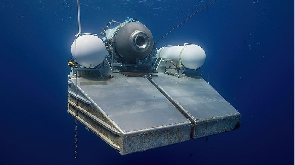 Foto of the Titanic submersible
Foto of the Titanic submersible
E be serious gbege, and sometin wey go really scare pesin - to dey trapped inside 22ft submersible, wey fit dey like thousands of feet underwater, wit oxygen wey don dey run out.
Di exact whereabouts of di Titanic submersible and di condition of di five crew onboard dey unknown. Di thinking now be say di vessel fit just get only few hours of oxygen wey remain, and e dey create rush-rush against time to fit find di sub before e go too late.
However, dat timeline no necessarily dey rigid, and Dr Ken LeDez, one hyperbaric medicine sabi pesin for Memorial University for St John, Newfoundland, don tell BBC News say, e depend on di konditions, wey some of those wey dey aboard fit survive longer dan e dey expected.
"E depends on how cold dem dey and how effective dey dey manage oxygen," e tok, e add say to dey shiver go use up plenti oxygen, while to wrap up togeda fit help to save up heat.
E say to run out of oxygen na gradual process. "No be like to switch off light, na like climbing mountain - as di temperature dey get colder and metabolism dey fall [e depends] how fast you go up dat mountain," e tok.
While admit say we no sabi di full situation inside di submersible, Dr LeDez say di konditions fit dey different pesin-to-pesin, and dat although na "disturbing conversation", some fit survive longer dan odas.
On Wednesday, Rear Admiral John Mauger from di US Coast Guard say e bin get number of unknowns for di search and rescue mission.
"We no know di rate of consumption of oxygen per occupant for di sub," Rear Adm Mauger bin tell di BBC.
Dr LeDez also tok say to run out of oxygen no be di only danger those on board dey face.
Di vessel fit don lost electrical power, wey fit likely get role for controlling di amount of oxygen and carbon dioxide inside di vessel.
As di oxygen level dey fall, di proportion of carbon dioxide wey dem dey breathe out by di crew go dey rise, wit potential fatal consequences.
"As levels of carbon dioxide dey build up, den e go become sedative, e go become like one anaesthetic gas, and you go go to sleep."
Too much of di gas inside pesin bloodstream, wey dey sabi as hypercapnia, fit kill dem if e no dey treated.
Former Royal Navy submarine captain Ryan Ramsey say e see videos online of di inside of Titan and no fit not see carbon dioxide removal system, wey we sabi as scrubbers.
"Dat for me be di greatest problem of all of dem," e tok.
For di same time, di crew dey at risk from hypothermia, wia body get dey too cold.
According to Capt Ramsey, if di sub dey on di seabed, di water temperature go dey about 0C. If e don also lost electricity, e no go dey generate any power and therefore no fit generate heat.
But hypothermia "fit be dia friend", Dr LeDez tok.
"E fit get possibility if dey cool down enof and lose consciousness dey fit live through am- rescuers sabi dis," e tok say, to add say di bodi go automatically try adapt to survive.
However on di flip side, hypothermia, di lack of oxygen and di build-up of carbon dioxide within di sub mean say di crew ability to make contact wit di search and rescue mission, such as by banging on di hull from time to time to try and attract attention, go reduce.
"If dem dey unconscious, dey no go fit able to do much to help demselves," Dr Ledez tok.
While di Coast Guard don warn say e just be little oxygen wey remain, di crew fit dey able to conserve dia supplies - at least for sometime.
Mr Ramsey tok say to slow dia breathing go also help but admit say dis fit dey difficult considering di stress dem go dey under.
Dr Ledez say dey fit also spread out carbon dioxide-absorbing granules or reduce dia power use if dey still get electricity.
In terms of food and water, di Coast Guard say di crew get some "limited rations" on board but no tok how much.
Despite all dis challenges, Dr Ledez urge against cancelling di search-and-rescue operation too soon, e say dey fit dey able to survive even wen oxygen levels dey very low.
"If anybodi fit survive inside am, you sabi, na dis pipo," Dr Ledez tok. "E just depend on dem to get power and depend on dem to get light to dey able to find tins and make dis controls, but absolutely, dey fit still dey alive."
Horizon Arctic - Commercial vessel dey loaded with support equipment
Glace Bay - Canadian naval ship carrying decompression chamber and ready to provide medical assistance
John Cabot - Scientific research vessel with sonar search capabilities operated by the Canadian Coast Guard